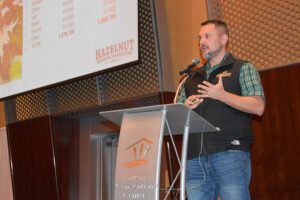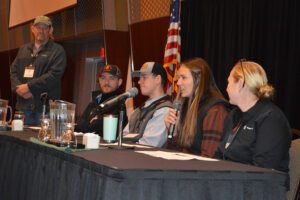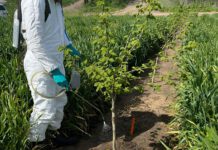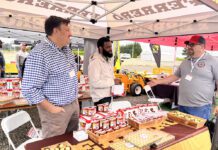
News that packers were paying hefty bonuses for hazelnuts helped put a positive spin on the 2024 Winter Meeting of the Nut Growers Society of Oregon, Washington and British Columbia, held January 11 in Salem, Ore.
Terry Ross of the Hazelnut Growers Bargaining Association said developments in Turkey, the largest hazelnut-producing country in the world, dramatically lowered world crop expectations and helped prompt three of the state’s largest packers to offer bonuses for the 2023 crop.
Ross noted crop estimates from Turkey dropped from around 800,000 tons to 600,000 to 650,000 tons as growers there struggled with stink bugs and weather issues. “There are still reports coming from the grower side that it’s 400,000 tons,” Ross said. “The marketers are saying it’s 700,000 tons. But when you look at what is happening within the marketplace, supply and demand tell you generally where it has fallen, and the 600,000- to 650,000-ton range is logical.”
Weather events and stink bug infestations also have reduced the crop in Italy, the second largest hazelnut producing country, from an estimated 110,000 tons to between 80,000 to 90,000 tons, Ross said. In addition, crop projections have decreased in Azerbaijan, Chile and Geogia within the last few weeks.
“We lost about 225,000 to 250,000 tons of potential crop supply,” Ross said. “So, that wiped out our excess and got us down to a very healthy place where prices are starting to improve dramatically.”
Coming after two years of poor prices and in some cases low yields, the news of the bonuses was greeted warmly by the 750 to 800 growers and others who crowded into the Salem Convention Center for the annual winter meeting.
Another factor affecting the hazelnut price, Ross said, is world economies are more vibrant today than at any time since 2019. “Nobody was going to build any new product lines and take a risk entering into the marketplace in a COVID-19 situation,” Ross said. “Now, those things are starting to happen, and we’re getting back to normal, we hope. The different economies are starting to fire back up, and it appears we’re heading back into a situation possibly where total supply is starting to fall and potential consumption is starting to increase.”
Ross also addressed an issue on the forefront of growers’ minds in recent years: That being that Oregon growers overplanted hazelnuts. “That is not why the prices softened recently,” Ross said. “We are still pretty small in comparison to the world’s hazelnut production.”
Despite the fact that Oregon’s hazelnut acreage increased from less than 30,000 in 2008 to around 93,000 acres in 2023, that still represents a small part of world supply, he said. For example, Ross said, growers in Turkey produce hazelnuts on roughly 2 million acres.
“So, if we go from 25,000 acres to 100,000 acres of production, it does not make a difference to the world market,” he said.

New EFB Strain
News of the price increases helped offset a disturbing revelation from an afternoon panel that a new strain of Eastern Filbert Blight (EFB) has overcome the resistance conferred by the Gasaway gene, which Oregon State University breeders used to develop many of the EFB resistant varieties currently in production, including the latest release, Thompson.
OSU Extension Orchard Specialist Nik Wiman, one of four panelists, said growers in the Woodburn area, where the new strain appears to have emerged, need to start thinking about spraying for EFB and cutting out diseased limbs, regardless of which variety they are growing.
“It pains me to encourage people to increase our fungicide use,” Wiman said. “But if you are close to the current epicenter, you definitely need to implement a strong EFB program.”
The panel session included a history lesson, where OSU Plant Pathologist Jay Pscheidt showed how EFB moved more than 120 miles from north of Vancouver, Wash. to the southern end of Oregon’s Willamette Valley in a matter of a few decades.
Jeff Newton, a grower and one of the panelists, urged growers and consultants to monitor for EFB presence in their orchards and treat for it before the disease has a chance to get a foothold in the valley.

Crop Management
Earlier in the meeting, another panel, this one made up of agronomists, addressed the topic of how to manage crops in times of tight budgets. Raymond Seal, agronomist for Marion Ag Services, said he typically gets two responses from his growers in lean times.
“One of the responses I get from customers is I’ve got to tighten my belt,” Seal said. “And that means trimming down the fat wherever I can. Where can I save costs and start looking at pinching pennies? And the other response that I think achieves the same thing but in a different way is I’m going to focus really hard on the important stuff.”
Seal said he views orchard maintenance as a critical management practice that needs to be done regardless of budgets. “The maintenance needs to be there, for sure. So, you can let soil go for a little bit if you’ve got built up fertility, but you don’t want to take that too far. Same thing with pruning. In my mind, you want to keep your cycle of pruning going.”
The idea, he said, is when prices improve, growers have a solid foundation to work from in their orchards.
Tawny Buck of Nutrien Ag Solutions agreed with what Seal said and noted the long-term nature of hazelnut orchards complicates issues in that what a grower does one year will affect production three to five years down the road.
“That makes it really hard for growers to make decisions,” Buck said. “A lot of guys, they don’t want to scale back. They don’t want to pull back on inputs. They want to keep putting inputs back into their orchard and keep investing into that long-term crop.”
“We’ve had to make some tough decisions on our end of things between fertilizers and chemicals,” said Buck, who also produces hazelnuts. “We’ve had to make some lists prioritizing where we put the dollars. Do we put it more into this orchard? Do we put it more in here?”
Buck said she has been focusing on maintaining the tree health and maximizing return on investment. “It’s not necessarily always getting that last nut to produce if it doesn’t pay,” she said. “So, we’re focusing on return of investment.”
Dustin Welters, a crop consultant for Pratum Co-op, pointed out taking care of soil pH is essential to maintaining yields in lean or good times. “pH is kind of the base of your plants’ ability to uptake those nutrients in the soil,” he said.
Welters said it is also critical to maintain adequate potash levels in soil. “A lot of my tissue samples are deficient if not severely deficient in potash,” he said.
Michelle Armstrong of Wilbur-Ellis noted keeping up soil moisture is also critical at all times, regardless of budgets. “Keep in mind, if there is not moisture in soil, your nutrients aren’t available. It doesn’t matter how many nutrients are there; if the tree can’t uptake it, it doesn’t really matter.”















